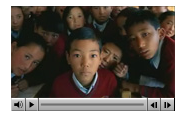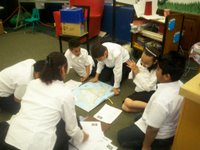
During the week of July 31st through August 4th, 18 teachers from my Region and I will be participating in a most unique and exciting videoconferencing professional development. It is called 123-VC! Jazzing Up Your Curriculum with Videoconferencing. The unique part of this PD is that it is conducted almost entirely through live interactive videoconferences with other teachers in Michigan, Texas and Missouri. It is also an opportunity for the participants in this training to simulate the kinds of projects and collaborations that their students will be doing in the coming school year. The planners which include distance learning leaders in 8 different school districts in 4 states have been working on this training for months and are using Moodle an online collaborative management system to develop the entire course. From schedules to handouts, from readings to blogs everything is posted in this online environment. The logistics of this training is daunting. Each day after a brief half hour of local time "taking care of business" and introducing or going over some of the important topics each location will connect to usually three other districts. One of the days all eight groups will connect to each other. Then all the participants will be introduced to a project or projects and then simulate the activity and videoconference that the project requires. Of course the simulations will be light hearted. For example
"MysteryQuest" a geography program where students research cities and countries in the World will be turned into "MysteryQuest Beaches". Our teachers will be finding those pleasure spots where sand and surf and fun take center stage. After lunch all eight sites will connect together for an hour to hear speakers on special topics. Then (and here is where logistics and daunting come into play) all 18 of my teachers will break into much smaller groups to connect to similar small groups to work on a vc project to do with their classes in the fall. So, I will need to provide at a minimum 5 other videoconferencing sites.
This week the pressure is on to ready the middle school we will be meeting at so there are at least 5 locations in the building where the teachers can go at the end of the day for their small group projects. I already have a vc unit in the media center. Another room that has an ISDN connection and is air-conditioned I hope to use for the majority of the day. However, I already had problems with the ISDN lines last Friday. So, I need to contact our local phone company Verizon first thing tomorrow. I hope to get another cable modem for the other library in the building and have cable installed in one of the computer labs. Of course I need to borrow additional Polycom units. Since the school right now has only two. So, my to do list for tomorrow looks something like this:
1. Call Verizon for ISDN repair.
2. Confirm TimeWarner for install on Tuesday.
3. Borrow 3 VC Units. Set-up and test.
4. Order breakfasts and lunches for five days.
5. Purchase binders for handouts
6. Copy handouts and fill binders
7. E-mail participants reminding them about the workshop (It is summertime and they do forget).
HELP!!!


















































